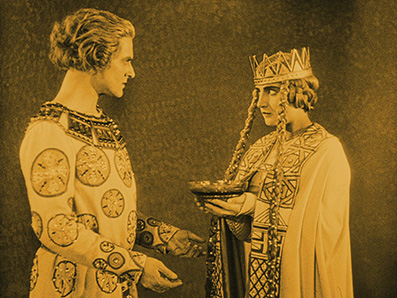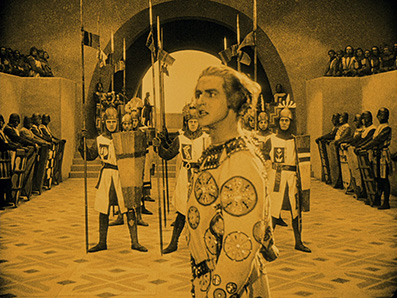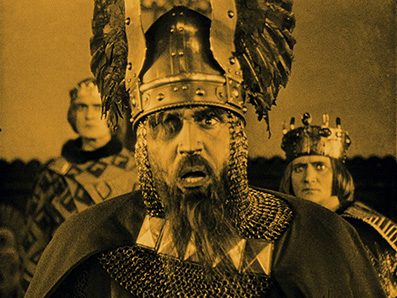|
For many of us, I'll wager, the name Nibelungen has been primarily associated with famed composer and antisemitic scribbler Richard Wagner's epic Der Ring des Nibelungen. Even if you're not a big fan of opera (guilty) you'll likely be all too familiar with a tune that graces Act 3 of Die Walküre; since its iconic use in Apocalypse Now, The Ride of the Valkyries has been used to underscore action sequences in everything from tacky commercials to witless feature comedies. Its story was partly inspired by the epic 11th Century poem Nibelungenlied, a tale that celebrated filmmaker Fritz Lang and his long-time collaborator Thea von Harbou (to whom he was then married) also believed was worth telling, even without the songs. The film they subsequently co-wrote and that Lang directed was so epic in length (381 minutes in total) that it was released as two separate features: Die Nibelungen: Siegfried and Die Nibelungen: Kriemhild's Rache [Kriemhild's Revenge]. And as with so much early Lang, they are fascinating works touched with moments of brilliance.
Despite its length and breadth, Siegfried begins at the tail end of an undramatised narrative arc. We are introduced to the Siegfried of the title – who, we are informed, is the son of King Siegmund of Xanten – as he triumphantly completes his training as a forger of swords by surpassing the skills of his tutor Mime. He is about to leave for home when he overhears talk of the Kings of Burgundy and the Princess Kriemhild, whose hand he becomes instantly determined to win. Jealous of Siegfried's skills and just a little pissed off at his aggressive demands for directions to Burgundy, Mime informs him of a short-cut through Woden Wood, a route designed to misdirect him and place him in mortal danger.

And so begins the sort of quest that fables are made of and that later became the basis for Joseph Campbell's The Hero with a Thousand Faces, itself a narrative blueprint for countless Hollywood movies to come. And if you know your Campbell, then the touchstones are easy to spot: Siegfried forges a great sword, fights and slays a dragon, achieves invincibility by showering in the creature's blood, receives a net of invisibility, becomes the richest king on earth by defeating the King of the Dwarves, conquers twelve kingdoms (this happens in the blink of an intertitle), and wins Kriemhild's hand in marriage by aiding her brother, King Gunther of Burgundy, to win his own bride. The Hero's Journey through and through.
Except it's not that simple. Not by a long chalk. Siegfried may have all the visual trappings of a storybook hero – he's golden-haired, good looking, brave and ambitious – but he's also a sometimes arrogant bugger with precious little humility, a man who helps Gunther to deceive his way into marriage and puts his own desires above the suffering of others. I'm not exaggerating here. Gunther, you see, has the hots for a frizzy haired firebrand named Brunhild, a woman I took an immediate liking to. More than a match for even the toughest and boldest knight, Brunhild will only marry the man who can best her in three physical challenges, something the weak and mopey Gunther has no chance of doing. Siegfried thus assists him by donning his net of invisibility and shadowing him during the quests, throwing spears and boulders for him and carrying him over the required giant leap. Gunther thus wins the reluctant Brunhild's hand, but Siegfried's willingness to aid him takes a far darker turn when he is ordered to break down Brunhild's angry resistance, which it is inferred he does by raping her in Gunther's image. All ambiguity is seemingly removed when Brunhild later rejects Gunther on the basis that her true husband is the man who took her maidenhood, and I'm quoting from the intertitles here. But even here all is not what it seems.

While this may not make it any easier to bond with our Siegfried, it does make him more interesting than the average storybook hero, and from the moment a leaf lands on his shoulder as he showers in dragon's blood – leaving one spot on his body still vulnerable to attack – it seems clear that he's unlikely to live a long and happy life. This is seemingly confirmed when his union with Kriemhild takes place some time before the first film's conclusion. And let's not forget that the title of the second film is Kriemhild's Revenge...
Although consciously divorced from Wagner, the film still has a sometimes operatic look and feel. This is particularly evident in Lang's use of wide shots in which the background in on the same plane as the camera, with characters positioned as if part of historical frescos. Coupled with the sometimes grand and expressive sets, this creates the sense of a strangely enclosed world, one whose borders do not extend that far beyond the edge of frame.
And yet from the moment Siegfried sets out on his journey to Burgundy, the film exerts an instant and disarming hold, propelled by Lang's skills as a storyteller and a narrative peppered with surprises and unexpected rewards. And while the first film has more than its share of sitting, talking and brooding, the set-pieces, when they come, tend to deliver the goods. Siegfried's early battle with the dragon is a case in point. A full-sized mechanical construction controlled by internally located human operators, it's a glorious creation, convincingly lowering its head to drink from a stream, breathing fire from its mouth, and bleeding profusely when mortally wounded. And if you don't think a film from 1924 has the power to startle, just watch where Siegfried lands his first damaging blow. The effects may be a tad primitive by current CG standards, but are impressively executed and purposefully employed, from the superimpositions used to turn the dwarves into stone or render Siegfried invisible, to a strikingly designed death-vision animation in which a tree is transformed into a human skull.

The politics of power-play that dominate the first film reach a peak in the more action-orientated second, when Hun leader Attila, a gargoyle of a man who resembles a sleep-starved member of the Klingon High Council, asks for Kriemhild's hand in marriage, which she accepts on purely tactical grounds. At this level, of course, personal vendettas can too easily become the basis for war, which explodes in a spectacular and extended climactic stand-off in which a seriously outnumbered party of Nibelungen soldiers barricade themselves in the enemy palace and do battle against wave after wave of attacking Huns.
In hindsight it's easy to see why Hitler's propaganda minister Joseph Goebbels was so besotted with the film, with its muscular Aryan hero sporting hood-ornament hair, it's bold warriors battling barbarian hoards, and its iconic images of swords being forged or held heroically aloft. But what begins as a fable is transformed by the selfishness of those in positions of power into a tragedy truly worthy of opera, one that leaves almost every name character either dead or with their lives in irreparable tatters. One can only assume that this portrait of the corrupting and ultimately destructive nature of power, revenge and unbridled ambition flew right over Goebbels' ridiculous head. It may lack the cinematic sophistication of Lang's 1922 masterpiece, Dr. Mabuse, der Spieler, but Die Nibelungen still tells a rattling good story in often enthralling fashion, and surprising though it may seem, it fully justifies that four-and-a-half-hour-plus running time.
It's hardly surprising that complete negatives of both films have not survived the ravages of time and wanton re-editing for international distribution, and indeed there are sections of Kriemhild's Revenge that have not yet been recovered and are quite possibly lost forever. The photochemical restoration here has once again been handled by the fine people at Friedrich-Wilhelm-Murnau-Stiftung, and made from incomplete camera negatives, with missing sections supplemented by archival copies and various extant prints of the period. Some digital image correction has also taken place and heavy damage has been retouched. It's not hard to spot the material drawn from prints rather than camera negative, in part because of its condition, but also because of how good the camera negative material looks. Yes, there are still some scratches visible and the picture flickers just a little, but for a film made in 1924 that has never been screened in its complete version, this is still seriously impressive. Almost all frame jitter has been stabilised, most traces of dust and damage have been removed, and the level of detail is sometimes remarkable – just take a look a the clarity of the chain links on Hagen Tronje's armour when he's photographed in medium shot or close up (sorry, but you'll need to see that on screen to really appreciate it).

The entire film has been rendered with a strong orange tint, reproducing how it played when first screened in cinemas, and according to the included documentary actually softens the harsher contrast of the untinted version. I'll admit to having a preference for straight monochrome over tinted prints and do feel that clarity suffers just a little (how can it not?), but it's well executed here and you quickly get used to its presence.
The original score written to accompany the film by Gottfried Huppertz has been reconstructed by here Marco Jovic and Frank Strobel and freshly recorded by the Europäische Filmphilharmoie. And it's an absolute treat. You have the choice of crystal clear stereo 2.0 or 5.1 surround, both in DTS-Master Audio, and the fact that there's not a huge amount of difference between the two is not a negative comment on the 5.1, but a tribute to the quality of the stereo track.
The Heritage of Die Nibelungen (71:25)
A German documentary, produced by F.W. Murnau-Stifftung, that looks back at the making of Die Nibelungen, the cuts resulting from its international distribution, its appropriation by Goebbels as "an exemplary national film", and its later reconstruction and restoration. It's a comprehensive and fascinating 71 minutes in which the film's production and subsequent fragmentation at the hands of international distributors gives a clear idea of the challenges faced by the restoration team. There's some great stuff in here, including side-by-side comparisons between different versions of the same sequence, and even extracts from later sound version. We also learn that the climactic fire was done for real and took the fire department an entire day to extinguish. An excellent extra.
Booklet
There's a teeny little part of me that almost wishes Masters of Cinema would produce just one even slightly substandard booklet so that I'd be able to talk about it without wallowing in superlatives, but it doesn't seem likely. On board here is an detailed essay on the film by Lang expert Lotte H. Eisner; an extract from Tom Gunning's acclaimed The Films of Fritz Lang: Allegories of Vision and Modernity (having become all excited when I noticed that the cross sewn on Siegfried's back to mark his point of vulnerability directly anticipated the chalk mark that is slapped on Peter Lorre's back in Lang's later M, I was almost disappointed to find that Gunning had nailed that one long before me); the always entertaining Lang himself on the making of the film; a brief appreciation by the great Michael Powell; a poem Ground Speech (After Lang) by Geoffrey O'Brien; a piece on the colour tinting; stills and credits. So yes, once again, it's a wonderful extra.
Any early work by Fritz Lang is well worth your time, and while Die Nibelungen never feels as startling or as innovative as the film it immediately followed, it's still a handsomely realised blend of heroism, politics, action and tragedy, one whose potential for large scale action is thrillingly realised in the climactic final battle. A superb restoration is backed by an excellent documentary and another terrific MoC booklet. Highly recommended.
|